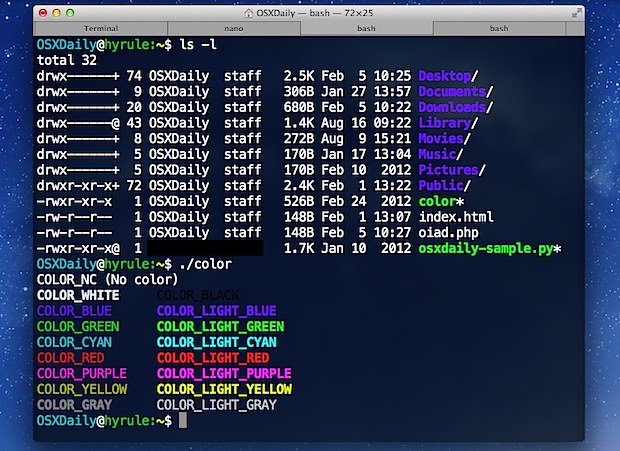Terminal (Terminal.app) is the terminal emulator included in the macOS operating system by Apple. Terminal originated in NeXTSTEP and OPENSTEP, the predecessor operating systems of macOS. When using Terminal on Mac, it might look like you are trying to hack into a system. While of course, it is not the case, knowing Mac Terminal commands will give you an upper hand in mastering the MacOS environment. As a Terminal emulator, it provides you with text-based access to the operating system. Dec 29, 2019 How to Open Applications Using Terminal on Mac. Apple's Terminal provides you with a UNIX command line inside the OS X environment. You can enter the open command here to open any application, or to open a file with the application of your.
| Developer(s) | Apple Inc. |
|---|---|
| Operating system | macOS |
| Platform | ARM64, x86-64, IA-32, PowerPC |
| Type | Terminal emulator |
| Website | www.apple.com/macosx/features/unix/ |
Terminal (Terminal.app) is the terminal emulator included in the macOSoperating system by Apple.[1] Terminal originated in NeXTSTEP and OPENSTEP, the predecessor operating systems of macOS.[2]
As a terminal emulator, the application provides text-based access to the operating system, in contrast to the mostly graphical nature of the user experience of macOS, by providing a command-line interface to the operating system when used in conjunction with a Unix shell, such as zsh (the default shell in macOS Catalina[3]).[4] The user can choose other shells available with macOS, such as the KornShell, tcsh, and bash.[4][5] Sodabuyerboy mac os.
The preferences dialog for Terminal.app in OS X 10.8 (Mountain Lion) and later offers choices for values of the TERM environment variable. Available options are ansi, dtterm, nsterm, rxvt, vt52, vt100, vt102, xterm, xterm-16color and xterm-256color, which differ from the OS X 10.5 (Leopard) choices by dropping the xterm-color and adding xterm-16color and xterm-256color. These settings do not alter the operation of Terminal, and the xterm settings do not match the behavior of xterm.[6]

Terminal includes several features that specifically access macOS APIs and features. These include the ability to use the standard macOS Help search function to find manual pages and integration with Spotlight.[citation needed] Terminal was used by Apple as a showcase for macOS graphics APIs in early advertising of Mac OS X,[citation needed] offering a range of custom font and coloring options, including transparent backgrounds.
Terminal Mac Command List
See also[edit]

Terminal includes several features that specifically access macOS APIs and features. These include the ability to use the standard macOS Help search function to find manual pages and integration with Spotlight.[citation needed] Terminal was used by Apple as a showcase for macOS graphics APIs in early advertising of Mac OS X,[citation needed] offering a range of custom font and coloring options, including transparent backgrounds.
Terminal Mac Command List
See also[edit]
- iTerm2, GPL-licensed terminal emulator for macOS
- Terminator, open-source terminal emulator programmed in Java
References[edit]
- ^'What Is Mac OS X - All Applications and Utilities - Terminal'. Apple Inc. Archived from the original on May 10, 2013.
- ^Wünschiers, Röbbe (January 1, 2004). Computational Biology: Unix/Linux, data processing and programming : with 19 figures and 12 tables. Springer Science & Business Media. ISBN9783540211426.
- ^'Use zsh as the default shell on your Mac'. Apple Support. Retrieved January 18, 2020.
- ^ abMcElhearn, Kirk (December 26, 2006). The Mac OS X Command Line: Unix Under the Hood. John Wiley & Sons. ISBN9780470113851.
- ^Kissell, Joe (January 1, 2009). Take Control of the Mac Command Line with Terminal. TidBITS Publishing, Inc. ISBN9781933671550.
- ^'nsterm - AppKit Terminal.app', terminfo.src, retrieved June 7, 2013
Terminal Mac Osx Brew Command
| Wikimedia Commons has media related to Terminal (macOS). |
Using screen as a serial terminal on Mac OS X
Geek Inc.Terminull Mac Os Catalina
If you develop on an Apple and find yourself doing any sort of device or embedded development, you will quickly find the need for a serial terminal on Mac. There are a few software apps out there, but I find it much simpler to simply use the terminal application 'screen'.
This works well particularly if you have an RS-232 serial to USB converter.
The first thing to do is determine which device you want to connect to.
Once you've determined which device you would like to use, you can execute the SCREEN command to start the serial terminal session on your Mac. Remember to specify the speed (baud rate) after the device name.
Once you've connected, you can use the terminal as you normally would.
To exit (and close the screen gracefully) press:
Screen will then prompt you to quit and kill all of your windows. Press 'y' and you'll be back to your shell terminal.
This method works equally well if you want to connect to a serial bluetooth device. You must simply make sure that the bluetooth device is paired and active. Then you will be able to see the device in the list of devices. Once you've connected to the serial bluetooth device with screen, the connection will be held active for the length of your session.
I've used this method to connect to the sparkfun Bluetooth Mate Gold. It simply appears as a serial stream that you can communicate with exactly as you would with any other serial device.

